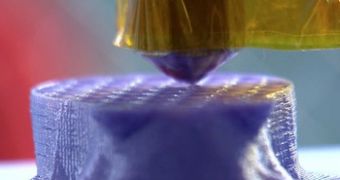We've been writing about 3D printers, 3D printing services and 3D printed objects for months now, but other than special techniques that have caught our eye, we have never actually explained how 3D printers work, or what other technologies exist. So we'll do it now.
Well, we've actually got the National Science Foundation to thank for this, since it went through the trouble of compiling the most often encountered processes.
First off, 3D printers work thanks to additive manufacturing, a way of making 3D objects by building up material, with the guidance of a digital design, layer upon layer.
MIT developed the technology back in 1989 (though the patent was only awarded in 1993) and started out as binder jetting.
Basically, you place a layer of powder, then squirt a liquid binder on the areas that need to go solid. Much like an inkjet printer really, but capable of more than one layer.
Other material jetting processes and directed energy deposition lie at the heart of similar additive manufacturing techniques.
There are others though, like selective laser sintering (vat photopolymerization), which first fills a vat with special resin, then subjects it to blast from light at a specific spectrum to harden it, to cure it as it were. Following a digital design, a laser selectively hardens liquid resin, a process called polymerization.
The method should not be mistaken for the other type of selective laser sintering though. That one uses a computer to fuse cross-sections of powder into a solid instead (ceramic, plastic, metal, polymer, etc.).
Sheet Lamination is another technology, where a laser cuts a thin sheet of paper, metal or plastic into a desired shape, then bonds another layer on top and cuts it I turn. Rinse and repeat, and voila! Intricate, complicate shapes.
Finally, material extrusion pushes liquid plastic or metal out through a nozzle, along the path of a digital map, like a pastry chef. The material hardens automatically and quickly when exposed to room temperature, allowing another layer to be easily added. This is the quickest method.

 14 DAY TRIAL //
14 DAY TRIAL //